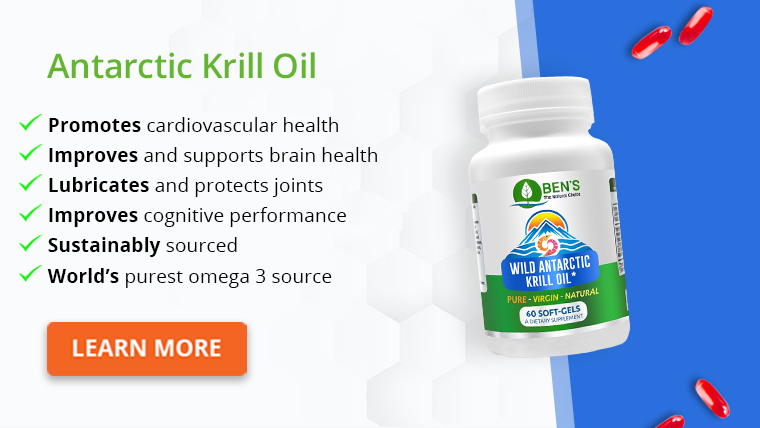- What is astaxanthin?
- What is astaxanthin made from?
- What is the difference between natural and synthetic astaxanthin?
- Benefits of astaxanthin
- Safety and effectiveness of astaxanthin
- What medications does astaxanthin interact negatively with?
- Best astaxanthin supplements
- What should you avoid in an astaxanthin supplement?
- Source
We’ve all heard of antioxidants. Those you probably know the best are vitamin C, vitamin A, and vitamin E. But how about astaxanthin?
As for many people, this might be a new one for you.
We will discuss what astaxanthin is, its sources, benefits, side effects, and the best supplement options.
What is astaxanthin?
Astaxanthin is a naturally occurring red carotenoid pigment, which is a form of vitamin A.
It is actually an oxidized version of a carotenoid. Astaxanthin is classified as a xanthophyll carotenoid. It is dipolar, meaning that it has two ends.
Each end has a hydroxyl group, which is a combination of a molecule of oxygen and a molecule of hydrogen.
When a substance has a hydroxyl group, this gives the molecule hydrophilic properties. This means that the molecule likes water. The fact that astaxanthin is hydrophilic makes it have better bioavailability.
Non-polar carotenoids, on the other hand, are less efficient at scavenging free radicals and therefore do not make a potent antioxidant as astaxanthin does.
Astaxanthin is best known for its effects on:
- Eye health
- Cardiovascular disease
- Alzheimer’s disease
- Male infertility
- Macular degeneration
- Those with high levels of low-density lipoprotein or low levels of high-density lipoprotein.
What is astaxanthin made from?
Astaxanthin is available naturally in food and is also made into nutraceuticals.
As far as food sources go, astaxanthin can be found in microalgae and seafood, such as salmon, trout, and shrimp.
Astaxanthin can be found in food, tablets, capsules, syrups, oils, soft gels, creams, biomass, and granulated powders.
The best source of astaxanthin is generally known to be Haematococcus pluvialis. This is because it is known as the most abundant natural source of astaxanthin.
It is also a strong antioxidant and has excellent commercial value. As a plant, it also can accumulate considerable amounts of astaxanthin.
Krill oil is an excellent source of astaxanthin. Antarctic krill oil is a product extracted from small, red crustaceans called Antarctic krill. It is often supplemented in either capsule or liquid form.
It is an alternative type of long-chain omega 3 fatty acid.
Krill oil contains two different types of omega 3 fatty acids:
- Docosahexaenoic acid (called DHA for short)
- Eicosapentaenoic acid (called EPA for short).

What is the difference between natural and synthetic astaxanthin?
Natural astaxanthin is often taken from Haematococcus pluvialis. It is obtained either through what’s called pressurized liquid extraction or supercritical antisolvent fractionation. Synthetic astaxanthin, on the other hand, is created in vitro, or a lab.
A scientific study was conducted for 13 weeks. This was a feeding trial with juvenile rainbow trout.
The goal was to test two different diets on the trout. One of these was a control diet without astaxanthin supplementation. The other was a diet supplemented with 100 mg per kg of trout weight of synthetic astaxanthin. During the last week of this feeding trial, the fish were exposed to an episodic hyperoxia challenge for eight hours in a row each day.
As expected, the episodic hyperoxia caused physiological stress responses. These were characterized by a significant increase in plasma cortisol and hepatic glycogen, as well as a decrease in plasma glucose levels.
The decline in plasma glucose and the increase in hepatic glycogen content due to episodic hyperoxia were emphasized with the synthetic astaxanthin diet.
Hyperoxia reduced most antioxidant enzyme activities in the liver. However, dietary natural astaxanthin supplements were able to increase the activity of the antioxidant enzyme glutathione reductase specifically.
Benefits of astaxanthin
- Antioxidant properties: Astaxanthin is a powerful antioxidant that works to bind to free radicals. It can quench singlet oxygen molecules and scavenge free radicals. Because of these antioxidant activities, astaxanthin can exert preventative effects against cardiovascular disease.
- Muscle Degeneration: Early research has shown that astaxanthin is effective at improving damage in the middle of the retina in people with age-related maculopathies, such as macular degeneration.
- Osteoporosis: Astaxanthin also upregulates the activity of osteocalcin, osteopontin, and type I collagen. This is why it can be helpful in osteoporosis. Furthermore, because of astaxanthin’s effect on Nfr2 signaling, it is also able to slow the degrading of bone that occurs in osteoarthritis. Astaxanthin is also able to block MAPK signaling, which reduces the inflammatory response that occurs in arthritis.
- Male fertility: Astaxanthin can also improve male fertility. It has also been shown to increase the pregnancy rates of partners of those diagnosed with infertility.
- Boosts Physical Performance: In a human study published in the International Journal of Sports Medicine, 21 competitive cyclists were randomly assigned to either a 4 mg/day astaxanthin group or placebo group for 28 days. The results showed that astaxanthin supplementation effectively decreased the time needed to complete a cycling exercise.
- Anti-aging: Astaxanthin prevents aging of the skin. Scientific studies have shown that it does this by preserving skin elasticity. This is because of astaxanthin’s ability to maintain moisture in the skin. Astaxanthin contains beta-carotene, which is known to have multiple benefits on skin health.
- Lowers Cholesterol: Astaxanthin can help those with high cholesterol due to its ability to inhibit oxidation of LDL (known as “bad cholesterol”). Astaxanthin also increases high-density lipoprotein, or HDL (known as “good cholesterol”). These effects have been shown in clinical studies.
- Protects Kidneys: Research has also shown that astaxanthin is renoprotective in nature, meaning that it helps to protect the kidneys.
- Diabetes management: Astaxanthin can be helpful in diabetes or other disorders related to glucose metabolism. It is via this mechanism that astaxanthin is also able to inhibit the proliferation of cancerous liver cells.
- Oxidative stress: There is something called nuclear factor erythroid 2-related factor 2, or Nrf2 for short. The activation of Nrf2 is a critical cellular defense mechanism against oxidative stress. Recent studies have demonstrated that astaxanthin protects against oxidative stress via the Nrf2 pathway.
One scientific study was conducted, investigating astaxanthin’s effect on emphysema via Nrf2 in mice. These mice were divided into four groups: control group, smoking group, astaxanthin groups, and astaxanthin + smoking group.
Mice in either of the smoking groups were exposed to cigarette smoke for 12 weeks. Mice in the astaxanthin groups were fed a diet containing astaxanthin. Researchers found that astaxanthin was able to increase expression levels of Nrf2 significantly.
- Cardiovascular disease: Increasing evidence is showing astaxanthin’s ability to prevent cardiovascular disease, mainly when used in combination with lutein and zeaxanthin. This is due to its potential to improve oxidative stress, blood flow, inflammation, fat, and glucose metabolism.
Safety and effectiveness of astaxanthin
There is some concern that higher doses of xanthophylls, such as astaxanthin, can be linked to an increased risk of skin cancer and stomach cancer.
However, research has found that this increased risk was not statistically significant. As long as you stick to the recommended doses, you should be able to take astaxanthin supplements safely.
When it comes to the maximum safe dose of astaxanthin, there are currently discrepancies. One group of researchers conducted a scientific review of approved dose levels.
They looked at clinical trials of natural astaxanthin as well as toxicological studies with natural and synthetic astaxanthin. Recommended or approved doses varied across different countries, ranging from 2 up to 24 milligrams.
They reviewed 87 human studies and found zero safety concerns with natural astaxanthin supplementation.
The European Food Safety Authority recently proposed an acceptable daily intake of 2 milligrams. This was based on a toxicological study in rats, using synthetic astaxanthin. S
What medications does astaxanthin interact negatively with?
Astaxanthin can have harmful interactions with medications that are changed by the liver’s cytochrome p450 2B6 and 3A4 substrates.
This is because astaxanthin can increase how quickly the liver breaks down these medications.
Therefore, this might decrease the effectiveness of these medications. It is important to talk to your health care provider if you are taking any medications before starting astaxanthin supplementation.
Astaxanthin can interact negatively with the following medications:
- Ketamine (Ketalar)
- Phenobarbital
- Orphenadrine (Norflex)
- Secobarbital (Seconal)
- Dexamethasone (Decadron)
- Diltiazem
- Nicardipine
- Verpamil
- Etoposide
- Paclitaxel
- Vinblastine
- Vincristine
- Vindesine
- Ketoconazole
- Itraconazole
- Glucocorticoids
- Fentanyl (Abstral, Actiq, Duragesic, Fentora, Sublimaze)
- Losartan (Cozaar)
- Fluoxetine (Prozac)
- Midazolam (Versed)
- Omeprazole (Prilosec)
- Ondansetron (Zofran)
- Propranolol (Inderal)
- Fexofenadine (Allegra)
Best astaxanthin supplements
The best astaxanthin supplements contain biodegradable materials.
When it comes to nutritional value, krill oil wins this round. Krill oil has a higher number of antioxidants, including astaxanthin.
Known as the king of the carotenoids, astaxanthin ability to fight free radicals is even more potent than well-known antioxidant powerhouses such as vitamin c or curcumin.
Our bodies do not produce enough essential fatty acids (EFAs). Therefore it is essential that we obtain them through our diet.
That’s where omega 3 comes in. Omega 3 is necessary for healthy brain development, hormone production, and even healthy skin, hair, and nails. Research suggests that about 90 percent of Americans today are deficient in omega-3s.
We’re eating too many omega-6s and not enough omega-3s. An imbalance between omega 3 (which is anti-inflammatory) and omega 6 (which is highly inflammatory) leaves the body exposed to every form of inflammatory disease.
You can also look at local health food stores. Do your own research and advocate for your health. Be sure to make an informed, knowledgeable decision when it comes to picking daily supplements that are best for you.
Get Your FREE Eye Health Diet Plan
- Nine most important vitamins for eye health
- How to naturally protect and improve your eye health as you age
- Developed exclusively by our medical doctor
What should you avoid in an astaxanthin supplement?
When getting an astaxanthin supplement, you should avoid fillers, additives, synthetic ingredients, unnatural ingredients, and genetically modified organisms, or GMO. It is also crucial that the supplement does not contain any toxic chemicals or heavy metals, such as mercury or lead.
You should also avoid supplements that are manufactured outside your own local country. This is because they may not be safe, and that country may not necessarily hold their products to the same standard as your country.
Avoid supplements with ingredients labeled as a “proprietary blend,” as they don’t list what the ingredients are.
Speak to your primary health care provider today to see if an astaxanthin supplement is right for you. If you have cardiovascular health concerns, problems with your eye health, diabetes, or any of the other health issues mentioned above, astaxanthin could have a striking effect on your health.







